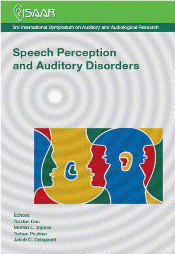Perceptual comparison of noise reduction in hearing aids
Abstract
Knowledge on perceptual consequences of single-microphone noise reduction in hearing aids is limited. We developed and evaluated a filtering method that allowed us to directly compare noise reduction systems from different hearing aids. Using this method, we compared noise reduction from four different hearing aids in a paired-comparisons design. Preference strength of our normal hearing subjects appeared to differ between noise reduction systems as well as between SNRs. Both factors are relevant for the interpretation of previous noise-reduction studies as well as for hearing- aid selection and fine-tuning.
References
Anderson, M. C., Arehart, K. H. and Kates, J. M., (2009). “The acoustic and peceptual effects of series and parallel processing” EURASIP Journal on Advances in Signal Processing, 2009, p.10.
Bentler, R. et al., (2008). “Digital noise reduction: Outcomes from laboratory and field studies” International Journal of Audiology, 47 (8), 447-460.
Boymans, M., and Dreschler, W. A., (2000). “Field Trials Using a Digital Hearing Aid with Active Noise Reduction and Dual-Microphone Directionality” Audiology, 39, 260-268.
Bradley, R. A. and Terry, M. E., (1952). “Rank Analysis of Incomplete Block Designs: I. The method of Paired Comparisons” Biometrika, 39, 324-345.
Chung, K., (2007). “Effective compression and noise reduction configurations for hearing protectors” The Journal of the Acoustical Society of America, 121 (2), 1090.
Dittrich, R., Hatzinger, R., and Katzenbeisser, W., (2004). “A log-linear approach for modelling ordinal paired comparison data on motives to start a PhD programme” Statistical Modelling, 4 (3), 181.
Houben, R., Brons, I. and Dreschler, W. A., (2011). “A Method to Remove Differences in Frequency Response Between Commercial Hearing Aids to Allow Direct Comparison of the Sound Quality of Hearing-Aid Features” Trends in Amplification.
Luts, H. et al., (2010). “Multicenter evaluation of signal enhancement algorithms for hearing aids” The Journal of the Acoustical Society of America, 127 (3), 1491- 1505.
Ricketts, T. A. & Hornsby, B. W. Y., (2005). “Sound Quality Measures for Speech in Noise through a Commercial Hearing Aid Implementing Digital Noise Reduction” Journal of the American Academy of Audiology, 16 (5), 270–277.
Versfeld, N.J. et al., (2000). “Method for the selection of sentence materials for efficient measurement of the speech reception threshold” The Journal of the Acoustical Society of America, 107 (3), 1671-1684.
Additional Files
Published
How to Cite
Issue
Section
License
Authors who publish with this journal agree to the following terms:
a. Authors retain copyright* and grant the journal right of first publication with the work simultaneously licensed under a Creative Commons Attribution License that allows others to share the work with an acknowledgement of the work's authorship and initial publication in this journal.
b. Authors are able to enter into separate, additional contractual arrangements for the non-exclusive distribution of the journal's published version of the work (e.g., post it to an institutional repository or publish it in a book), with an acknowledgement of its initial publication in this journal.
c. Authors are permitted and encouraged to post their work online (e.g., in institutional repositories or on their website) prior to and during the submission process, as it can lead to productive exchanges, as well as earlier and greater citation of published work (See The Effect of Open Access).
*From the 2017 issue onward. The Danavox Jubilee Foundation owns the copyright of all articles published in the 1969-2015 issues. However, authors are still allowed to share the work with an acknowledgement of the work's authorship and initial publication in this journal.


